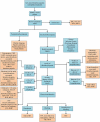New-onset acute thrombocytopenia in hospitalized patients: pathophysiology and diagnostic approach
- PMID: 28808508
- PMCID: PMC5538216
- DOI: 10.1080/20009666.2017.1335156
New-onset acute thrombocytopenia in hospitalized patients: pathophysiology and diagnostic approach
Abstract
Thrombocytopenia is a hematological finding commonly encountered in daily clinical practice from asymptomatic clinic patients to critically ill intensive care unit patients. A broad spectrum of etiologies and variation in clinical presentation often present a diagnostic challenge. Furthermore, concomitant presence of thrombosis and thrombocytopenia, as in cases of thrombotic thrombocytopenia, complicates the management. In hospitalized patients, new-onset thrombocytopenia is an important reason for hematology consultation. Therefore, it is of utmost importance that the etiology is diagnosed accurately. In addition, a basic understanding of the pathophysiology and the differential diagnosis avoids delay in the diagnosis and leads to rapid initiation of treatment. This review will address causes of thrombocytopenia that arises in hospitalized patients with an emphasis on the pathophysiological basis of each disorder.
Keywords: Thrombocytopenia; hospital acquired; pathophysiology; thrombopoiesis; thrombopoietin.
Figures



References
-
- Buckley MF, James JW, Brown DE, et al. A novel approach to the assessment of variations in the human platelet count. Thromb Haemost. 2000;83(3):480–484. - PubMed
-
- Maes M, Scharpé S, Cooreman W, et al. Components of biological, including seasonal, variation in hematological measurements and plasma fibrinogen concentrations in normal humans. Experientia. 1995;51(2):141–149. - PubMed
-
- McMahon CM, Cuker A.. Hospital-acquired thrombocytopenia. Hosp Pract. 2014;42(4):142–152. - PubMed
-
- Akca S, Haji-Michael P, de Mendonça A, et al. Time course of platelet counts in critically ill patients. Crit Care Med. 2002;30(4):753–756. - PubMed
-
- Crowther MA, Cook DJ, Meade MO, et al. Thrombocytopenia in medical-surgical critically ill patients: prevalence, incidence, and risk factors. J Crit Care. 2005;20(4):348–353. - PubMed
Publication types
LinkOut - more resources
Full Text Sources
Other Literature Sources
